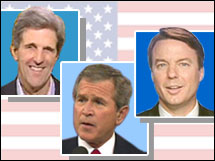NEW YORK (CNN/Money) -
Madison Avenue loves a good political fight. And the final battle in the war for control over the White House and Congress is likely to be a doozy, generating by some estimates as much as $1.5 billion in advertising.
But don't think that means the captains of the TV industry -- Viacom Inc.'s CBS, Walt Disney Co.'s ABC, General Electric Co.'s NBC and Fox, a unit of News Corp. -- are going to be cashing in on this titanic infusion of ad dollars.
Instead, the consensus among analysts is that the big winners are likely to be station owners in local markets.
Why? Because the bulk of political advertising leading up to the Nov. 2 election will be concentrated in the 10 or so battleground states likely to decide who resides in the White House for the next four years. These toss-up states include Florida, Ohio, Missouri, Nevada and New Mexico.
"'All politics is local' -- even in national Presidential elections," Morgan Stanley analyst Michael Russell told clients recently. "Just like what happened in 2000, we expect almost all of the national campaign spending to be done locally."
According to Russell, a scant 0.1 percent of television ad spending in 2000 was on the major networks, with the remainder going to local spot advertising. For perspective, added Russell, 25 percent of national political ad spending went to networks in presidential campaigns between 1972 and 1992.
When it comes to drawing campaign ad dollars, the top dogs are likely to be mid-cap companies such as Hearst-Argyle, (HTV: down $0.04 to $24.97, Research, Estimates) which is known for its strong news operations and owns stations in five battleground states.
Other potential beneficiaries include Sinclair Broadcasting, Emmis, and Journal Communications. Sinclair (SBGI: down $0.28 to $9.95, Research, Estimates) has a stake in seven battleground states, while Emmis (EMMS: up $0.04 to $20.15, Research, Estimates) has properties in four, while Journal (JRN: down $0.11 to $18.43, Research, Estimates) is a significant player in Wisconsin and Nevada.
 |
|
| Political advertising will benefit regional broadcasters more than national players. |
As for radio, Russell projects that Cox Radio (CXR: down $0.12 to $16.76, Research, Estimates), Cumulus (CMLS: down $0.20 to $15.51, Research, Estimates) and Radio One (ROIAK: up $0.09 to $15.00, Research, Estimates) -- each of which has sizable stakes in Florida and Ohio -- should rake in some ad bucks, although less than TV broadcasters.
To be fair, all broadcasters should benefit, including cable operators. So industry giants such as Viacom (VIAB: up $0.01 to $34.43, Research, Estimates) and Disney (DIS: down $0.13 to $24.22, Research, Estimates) will partake of the giant pie, only their slices will be smaller. The impact on the conglomerates' bottom lines will be far less noticeable given the breadth of their overall operations.
Big year seen for industry
The coming $1.5 billion political ad windfall is one of the main drivers behind current projections that 2004 will be a blockbuster year in advertising. Recent estimates peg total ad growth in the U.S. for the year at 7 to 9.3 percent, or as much as $140 billion.
Another factor behind the rosy projections is next month's Olympic Games in Greece. Last week, General Electric (GE: up $0.22 to $32.82, Research, Estimates), the parent of Olympics broadcaster NBC, announced it expects total revenue from the two-week sporting event to reach a record $900 million.
"We believe it's a record year (overall)," said Steven Fredericks, the CEO of TNS Media Intelligence/CMR. Last month, the New York-based market research firm estimated ad growth for the second half of 2004 would reach 9.2 percent, down slightly from the 9.4 percent growth rate in the first half.
Less bullish is Morgan Stanley media analyst Richard Bilotti. He told clients last week that ad sales, not including Internet advertising, would approach 5.8 percent for the year, down from 6.1 percent at the beginning of the year. Factor in Internet ads and Bilotti's growth estimate rises to 7 percent.
Bilotti pointed to two factors: lackluster growth in the radio market, which he said is losing ground to the Internet, and stagnant rates for prime time network advertising.
The end of the so-called quadrennial effect -- the spike in ad spending that comes once every four years thanks to the presidential election and the summer Olympics -- is one reason why analysts agree that the growth in ad spending will slow considerably in 2005.
The coming ebb in year-over-year growth should surprise no one given the strength of the ad market this year and the contributions made by politics and the Olympics.
"From an analytical perspective you're thinking '2 percent sucks,'" said Paul Kim, a media and entertainment analyst with Tradition Asiel Securities. "But it's like the pink elephant in the room. Everyone knows it's there."
There are also variables that could come into play that no one can predict right now, including signs of a slowing economy, terrorism, and ongoing strife in Iraq.
For now, thank George Bush and John Kerry for making this a great time to own a TV station in Florida.

|

